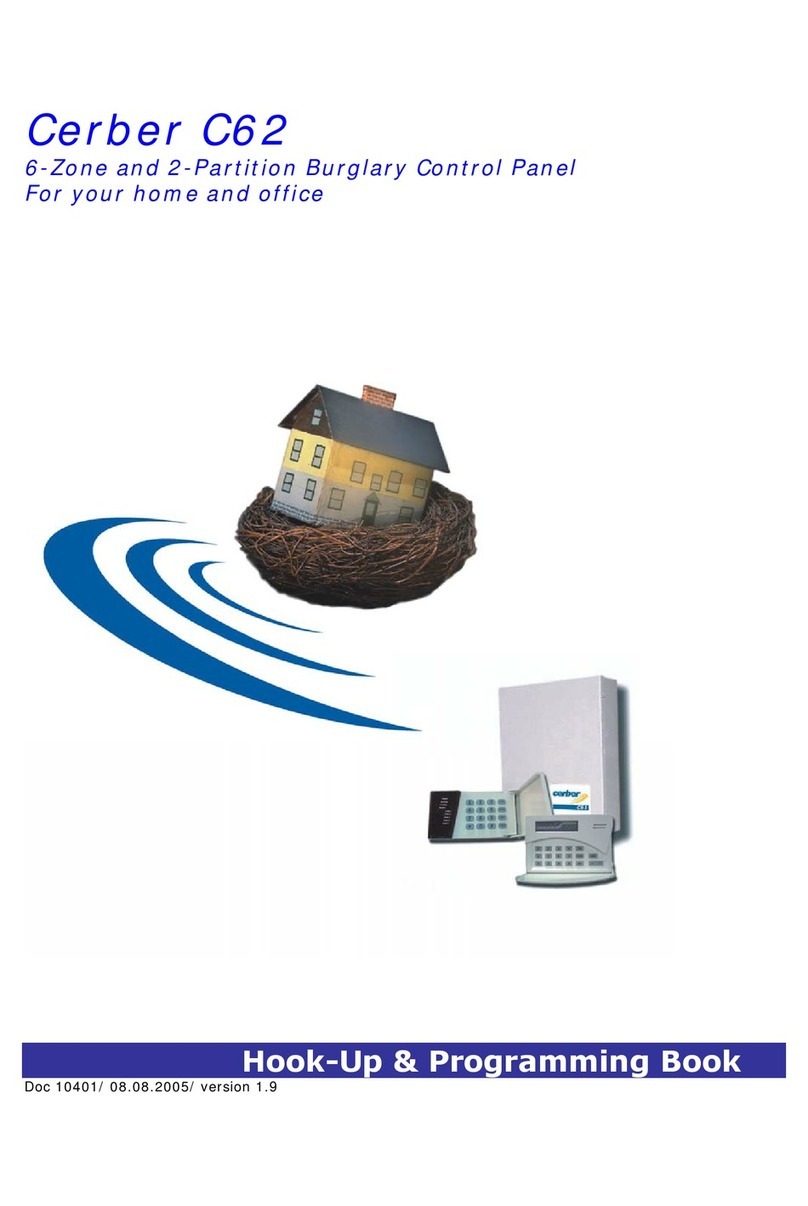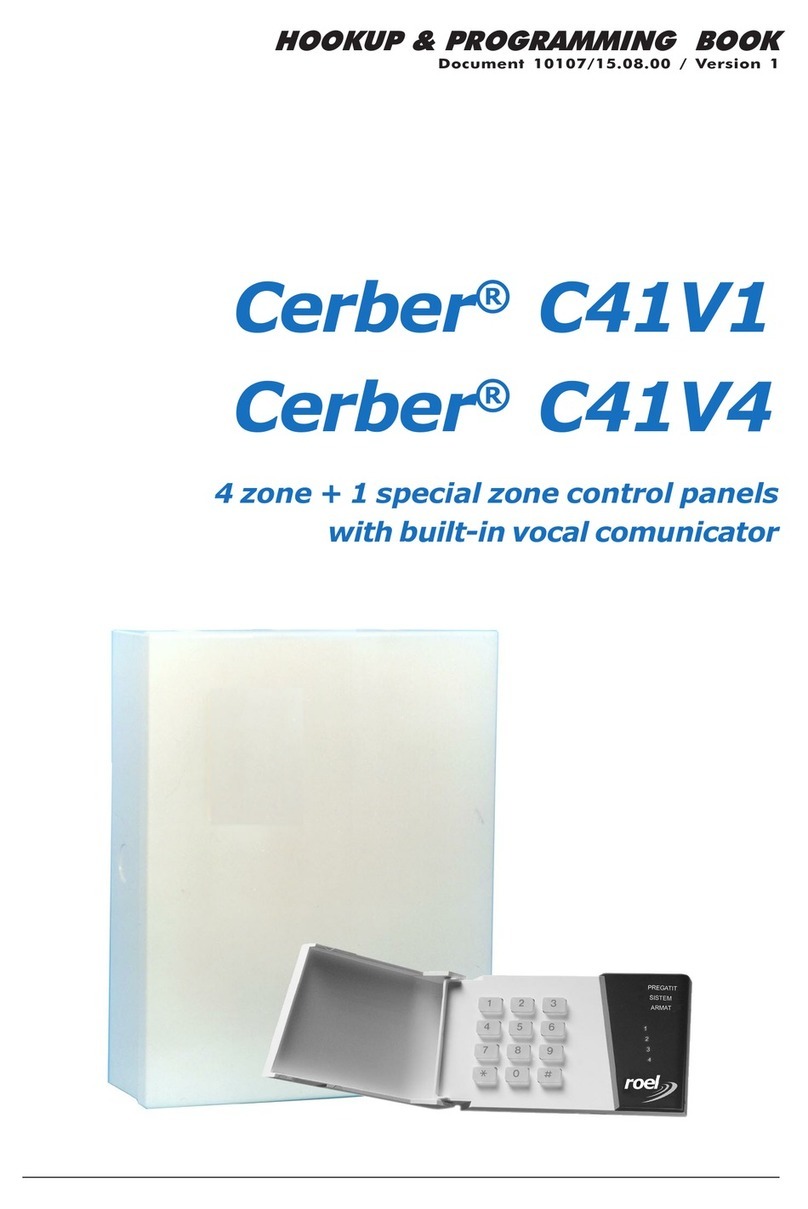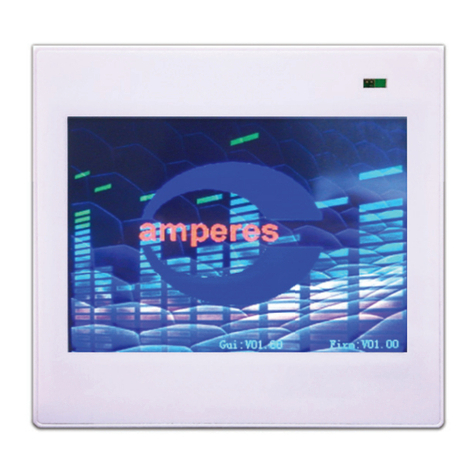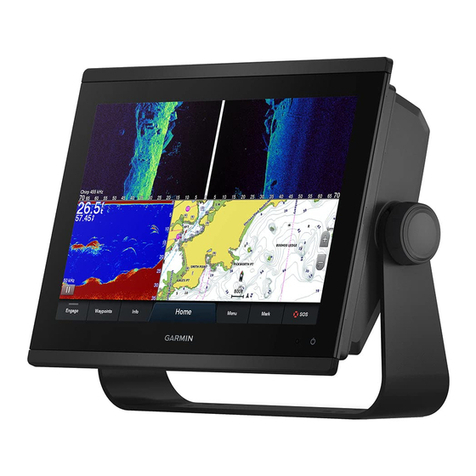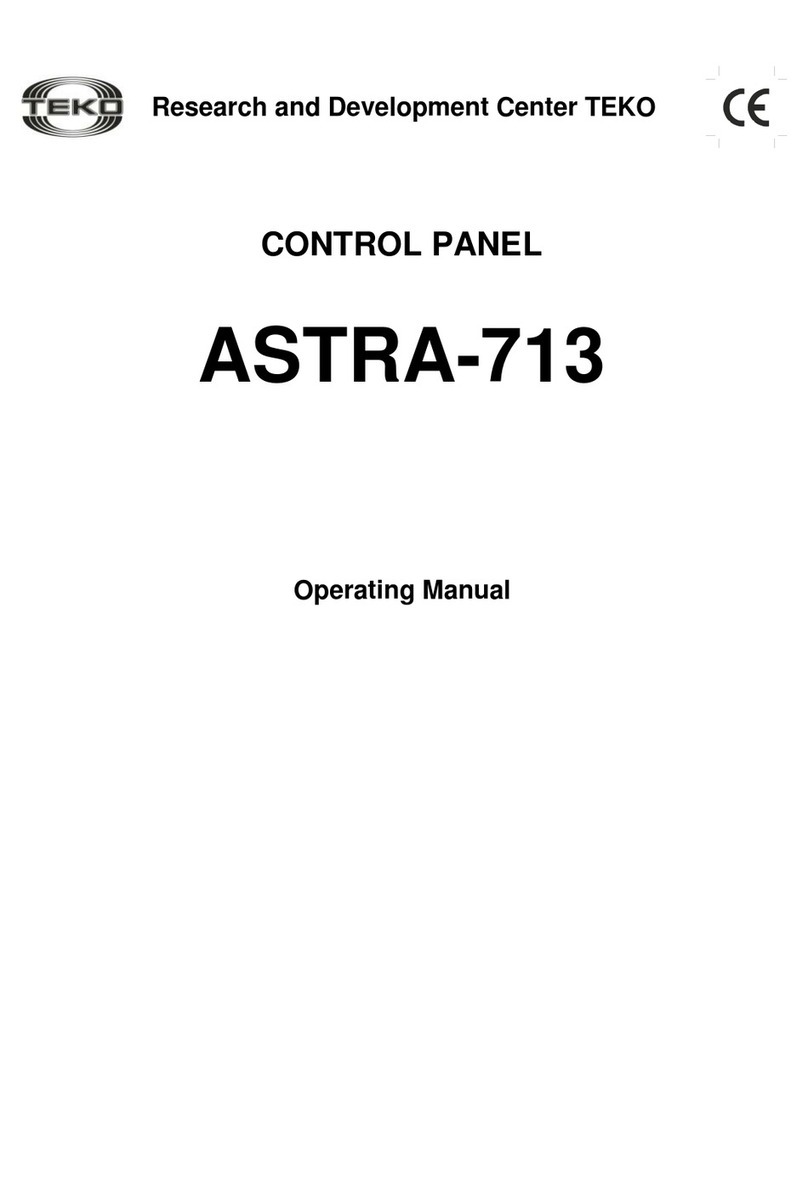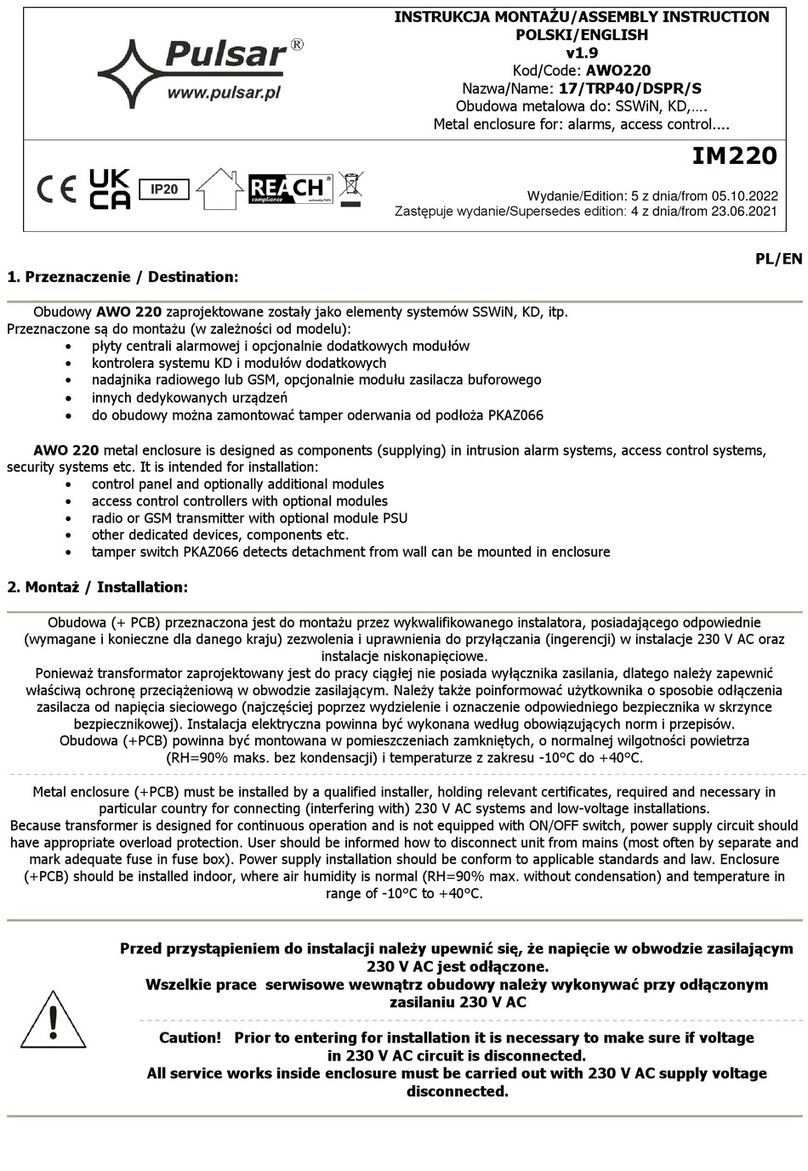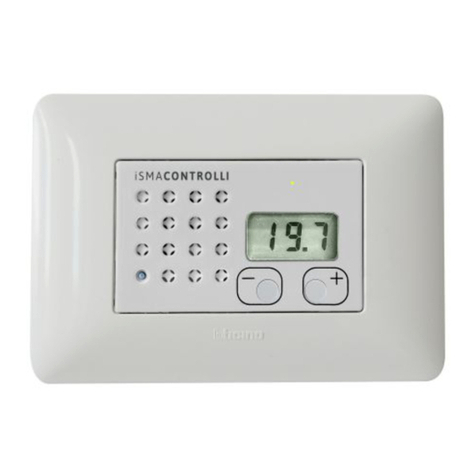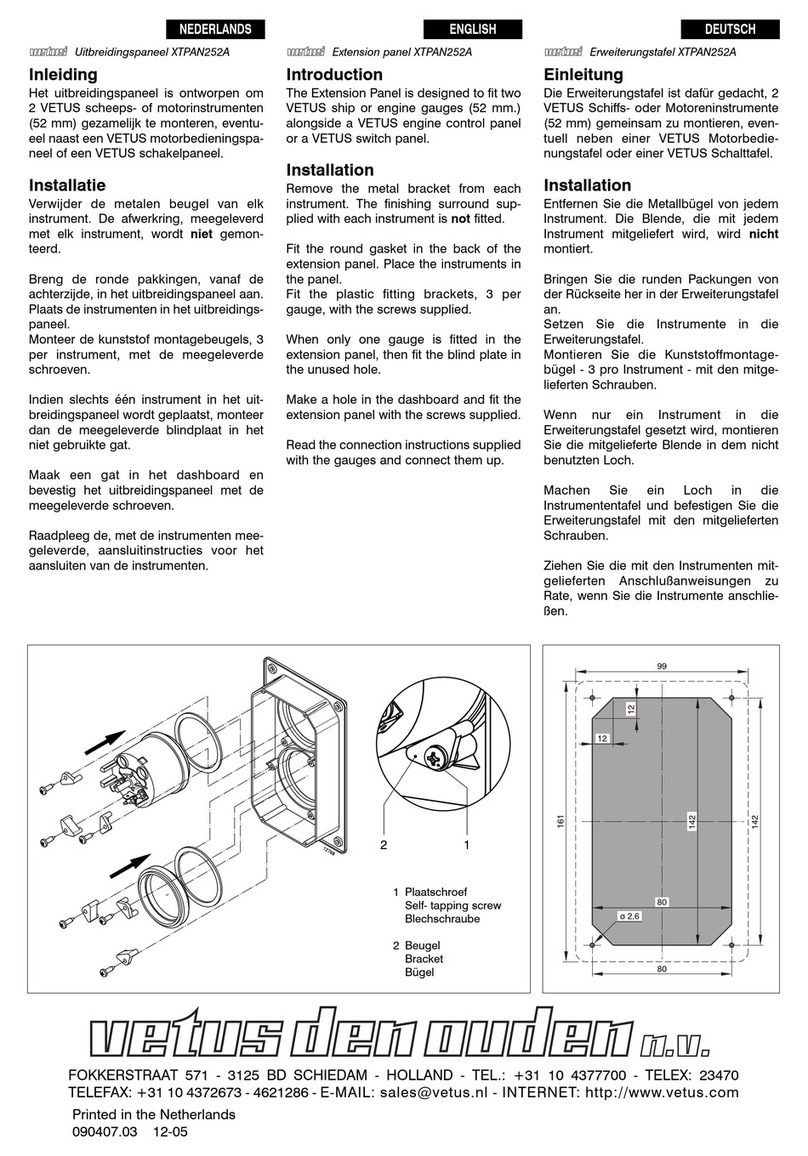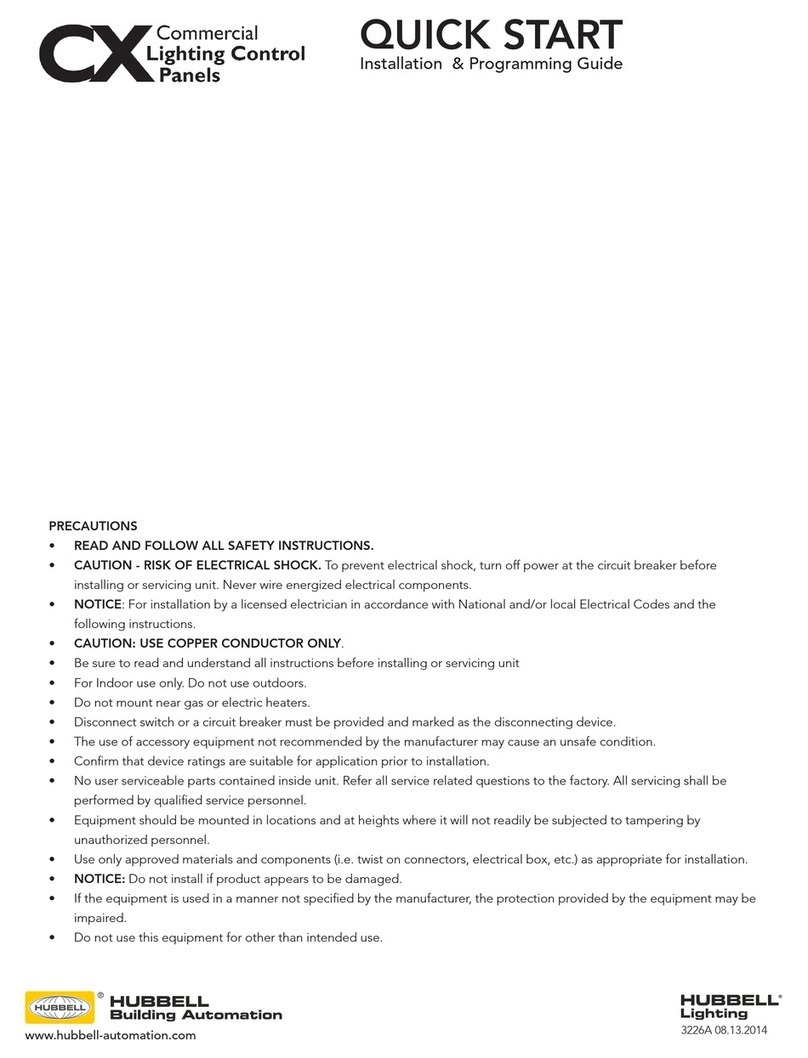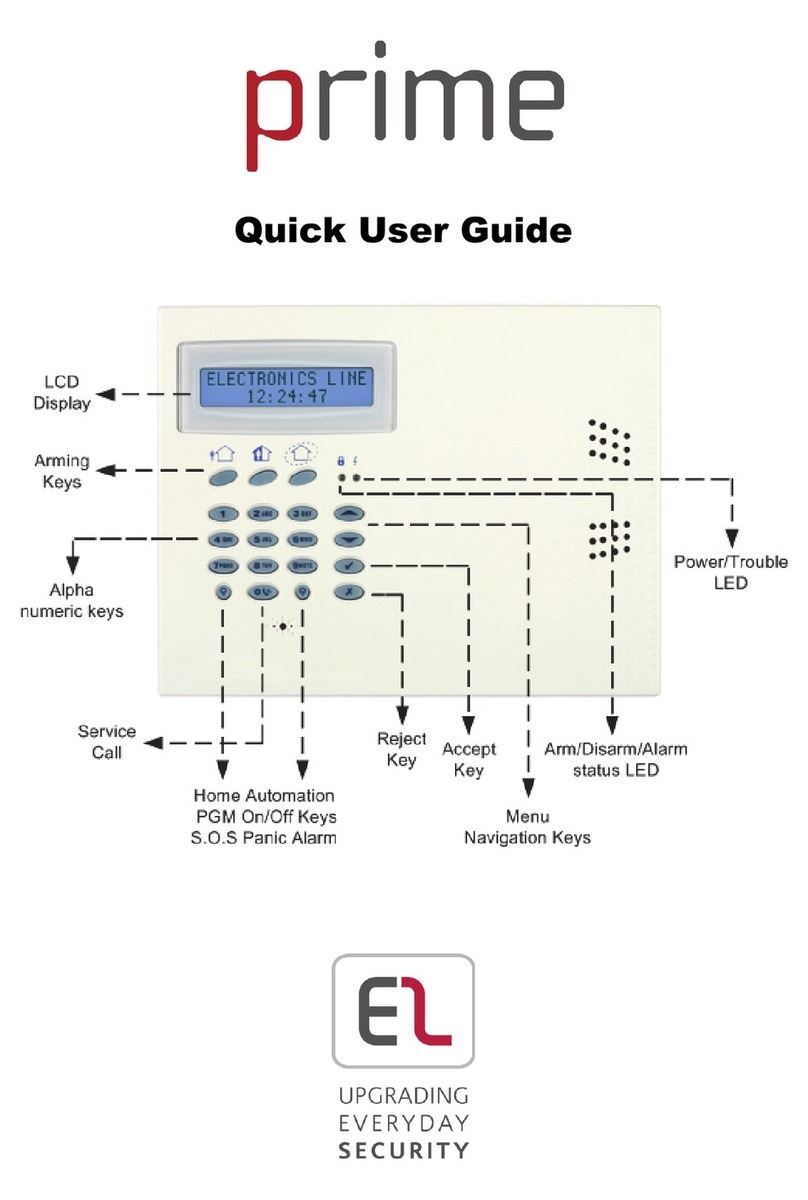ROEL CERBER C52 Assembly instructions

CERBER C52/C82
10/16-Zone LED Keypad Operated Alarm Control Panel
Installation and Programming Manual
March 2016/ version 3.0.

2
Table of contents
1. INTRODUCTION ..................................................................................................................... 4
General Features ............................................................................................................................................. 4
User Codes...................................................................................................................................................... 4
Installer Codes ................................................................................................................................................ 4
Digital Communicator ....................................................................................................................................... 4
Upload/Download............................................................................................................................................. 5
Zones............................................................................................................................................................. 5
PGM functions ................................................................................................................................................. 6
Monitoring of system troubles ............................................................................................................................ 6
Synthesis Sound Communicator ......................................................................................................................... 6
Miscellaneous .................................................................................................................................................. 6
Technical Specifications: ................................................................................................................................... 7
Power ........................................................................................................................................................ 7
Inputs ........................................................................................................................................................ 7
Main Board Outputs ..................................................................................................................................... 7
2. KEYPADS .............................................................................................................................. 8
Keypad types .................................................................................................................................................. 8
Keypad layout ................................................................................................................................................. 8
3. INSTALLING AND COMMISSIONING .......................................................................................... 11
Mounting the Panel......................................................................................................................................... 11
Mounting the Keypad...................................................................................................................................... 11
Wiring .......................................................................................................................................................... 11
Connectors.................................................................................................................................................... 12
Commissioning .............................................................................................................................................. 13
Reset to Default procedure.......................................................................................................................... 13
4. OPERATION......................................................................................................................... 14
System codes ................................................................................................................................................ 14
User Codes.................................................................................................................................................... 14
Installer’s Code.............................................................................................................................................. 15
Partitioning ................................................................................................................................................... 15
How does a partitioned system work?........................................................................................................... 15
Regular / Away Arming ................................................................................................................................... 15
Other Arming Modes....................................................................................................................................... 16
Timed Autoarming.......................................................................................................................................... 16
Inactivity Autoarming ..................................................................................................................................... 16
„Instant Stay” Arming..................................................................................................................................... 17
„Stay Arming” ............................................................................................................................................... 18
Switch to Stay Arming .................................................................................................................................... 19
Keyswitch or Pushbutton Arming/Disarming....................................................................................................... 19
Quick Arming Modes (Arming without user codes) .............................................................................................. 19
„Away Quick Arming”...................................................................................................................................... 19
„Quick Instant Stay Arming” ............................................................................................................................ 19
„Quick Stay Arming”....................................................................................................................................... 19
Disarming & Deactivating an Alarm .................................................................................................................. 19
Other Operation Commands ............................................................................................................................ 20
Zone bypassing ............................................................................................................................................. 20
System Trouble Displaying: [*][4] command ..................................................................................................... 21
Alarm Memory Displaying................................................................................................................................ 22
Next Trouble Beeps or Chime Feature Activating / Deactivating ............................................................................ 23
5. Master User’s Programming Menus ........................................................................................... 23
Programming / Selective Erasure (except the „master code”) of 01 to 30 User Codes ............................................. 24
Simultaneous Erasure of all users' codes (except the „master code”)..................................................................... 26
Programming / Selective Erasure of the 1 to 4 follow me Phone Numbers ............................................................. 26
Program the 1-st Follow me Phone Number: ................................................................................................... 27
Program the 2-nd Follow me Phone Number: .................................................................................................. 27
Program the 3-rd Follow me Phone Number: ................................................................................................. 27
Program the 4-th Follow me Phone Number: ................................................................................................. 27
Selective Erasure of the follow me phone numbers ............................................................................................. 27
Erase the 1-st follow me phone number: ........................................................................................................ 27
Erase the 2-nd follow me phone number: ....................................................................................................... 27
Erase the 3-rd follow me phone number:........................................................................................................ 27
Erase the 4-th follow me phone number: ........................................................................................................ 27
Simultaneous Erasure of all Follow me Phone Numbers ....................................................................................... 28
Programming session of the system date and hour ............................................................................................. 28
Activation / Deactivation Command for PGM Outputs (only for mono-stable/bi-stable and “clock timer” PGM type)Error! Bookmark not defined.
Online Download (PC programming acceptance)................................................................................................. 28
Cancellation of the Sound communication and the Upload/download Process.......................................................... 29
Keypad Special Alarms.................................................................................................................................... 29
6. SYSTEM PARAMETERS’ PROGRAMMING ...................................................................................... 30
Programming Sections .................................................................................................................................... 31

3
Sections [01] … [10]/[16] (1 to 10/16 zones’ defining) ................................................................................... 31
Section [01] - Defining zone 1..................................................................................................................... 35
Section [02] - Defining zone 2..................................................................................................................... 35
Section [03] - Defining zone 3..................................................................................................................... 35
Section [04] - Defining zone 4..................................................................................................................... 35
Section [05] - Defining zone 5..................................................................................................................... 35
Section [06] - Defining zone 6..................................................................................................................... 35
Section [07] - Defining zone 7..................................................................................................................... 36
Section [08] - Defining zone 8..................................................................................................................... 36
Section [09] - Defining zone 9..................................................................................................................... 36
Section [10] - Defining zone 10 ................................................................................................................... 36
Section [20] – 1-st set of General System Options .......................................................................................... 37
Section [21] – 2-nd set of General System Options.......................................................................................... 37
Section [22] – 3-rd set of General System Options .......................................................................................... 38
Section [23] – 1-st set of 1-st Partition Options................................................................................................ 38
Section [24] – 1-st set of 2-nd Partition Options ............................................................................................... 39
Section [25] – 2-nd set of 1-st Partition Options ............................................................................................... 39
Section [26] – 2-nd set of 2-nd Partition Options .............................................................................................. 40
Section [27] – 4-th set of General System Options (telephone options) .............................................................. 40
Section [28] – 5-th set of General System Options (digital COMMUNICATOR) ...................................................... 41
Section [29]: “Swinger Shutdown Counter” / “Keypad Lockout Counter” ........................................................... 42
Section [30] - Entry Delay 1 / Entry Delay 2 Timers ....................................................................................... 42
Section [31] - Exit Delay 1 / Exit Delay 2 Timers............................................................................................ 43
Section [32] – Burglary / Fire Bell cut-off timings........................................................................................... 44
Section [33] – „Time window for Intellizones”................................................................................................ 44
Section [34] - Delay for „AC power Loss / Restore” Transmission (01-99 minutes).............................................. 44
Section [35] - Activation time for PGM1 and PGM2, defined as pulse type (001 to 255 seconds) ........................... 44
Section [36] - Ring Number after that the Control Panel Answers to the Remote Calls......................................... 45
Section [37] – Number of sound dialing sequences / Time of the Sound Reporting.............................................. 45
Section [38] – Time between the Periodical tests (in hours or minutes)............................................................. 45
Section [39] - PGM1 and PGM2 Type Programming ........................................................................................ 46
Section [40] to [45] – EVENT Reporting Codes in Contact ID Format: ............................................................... 47
Section [40] – Event Reporting regarding: „Arming by user” / „Stay Arming by User” / „Disarming by user” /
„User under Duress” / „ Auto Arming Cancellation” / „ Keypad Tamper Alarm” / „ Keypad Tamper Restore” ........... 47
Section [41] – Event Reporting regarding: „ Auto Zone Shutdown” / “Zone Bypassed” / “Burglary Alarm” /
“Tamper alarm” / “Panic alarm” / “Fire alarm” / „Medical emergency alarm” ...................................................... 47
Section [42] – Event Reporting regarding: “Zone Alarm Restore” / “Zone Tampered Restore” / “Arming By
Keyswitch” / “Disarming By Keyswitch” / “Keypad Lockout” / “Module Removed” / “Module Added” ...................... 47
Section [43] – Event Reporting regarding: “Arming By PC Software” / “Timed Autoarming” / “Inactivity
Autoarming”/ “Quick Arming” / “Quick Stay Arming” / “Disarming By PC Software” / “Timed Auto Disarming” ........ 47
Section [44] – Event Reporting regarding: “Partial Arming” / “Fail to Autoarm” / “AC Power Failure” / “Battery
Failure” / “Bell Trouble” / “Auxiliary Supply Trouble” / “Time & Date Inaccurate” ................................................ 48
Section [45] – Event Reporting regarding: “AC Power Restore” / “Battery Voltage Restore” / “Bell Trouble
Restore” / “Auxiliary Supply Restore” / “Time & Date Reprogrammed” / “Periodical Test Report” .......................... 48
Section [46] – Moment for the First Periodical Test (hour:minute) .................................................................... 48
Section [47] – „Inactivity Time” after that the System / Partition A will Auto Arm (hour & minute)........................ 48
Section [48] – „Inactivity Time” after that the Partition B will Auto Arm (hour & minute) ..................................... 49
Section [49] – Installer’s code Programming ................................................................................................. 49
Section [50] – Master Code Programming, performed by installer..................................................................... 50
Section [51] – Activation Moment for PGM1 as “Clock Timer” (hour:minute) ...................................................... 51
Section [52] – Deactivation Moment for PGM1 as “Clock Timer” (hour:minute) .................................................. 51
Section [53] – Activation Moment for PGM2 as “Clock Timer” (hour:minute) ...................................................... 52
Section [54] – Deactivation Moment for PGM2 as “Clock Timer” (hour:minute) .................................................. 52
Section [55] – Auto Arming Moment for System / Partition A (hour:minute) ...................................................... 52
Section [56] – Auto Disarming Moment for System / Partition A (hour:minute) .................................................. 52
Section [57] – Auto Arming Moment for Partition B (hour:minute).................................................................... 53
Section [58] – Auto Disarming Moment for Partition B (hour:minute)................................................................ 53
Section [59] - First Panel Account for CS reporting......................................................................................... 53
Section [60] - Second Panel Account for CS reporting..................................................................................... 53
Section [61] - First Phone Number for CS reporting........................................................................................ 54
Section [62] - Second Phone Number for CS reporting.................................................................................... 54
Section [63] - Panel identification Code upon upload/download........................................................................ 55
Section [64] - PC identification Code upon upload/download............................................................................ 55
Section [65] - Online Download (PC programming acceptance) ........................................................................ 55
Section [66] - Cancellation of Phone Communication ...................................................................................... 56
Warning Limitations of Alarm Systems .............................................................................................................. 57
Technical Specifications .................................................................................................................................. 58

4
1. INTRODUCTION
GENERAL FEATURES
• Central unit's core of powerful RISC microprocessor;
• The electrical features include an EEPROM memory for the programmed configuration,
system/partitions status and LOG buffer to be retained even after a total power loss;
• User-friendly programming of the system parameters, from keypad or by PC (using
„EZcom C52/C82 Software”);
• Up to 425 events with time and date stamp can be stored in a FIFO LOG buffer;
• “False alarm prevention” features: intellizones, automatic zone shutdown, beeps on
entry and exit delays;
• High-speed Communication Format;
• 30 user codes (1-st being „master code”) and 1 installer programming code;
• Keypad displayed alarm memory alarms occurred in the system since last arming;
• Up to 4 keypads which can be simultaneously 4-wire coupled to one central unit;
• Keypad protection using micro-switch tamper;
• Individual zone LEDs from 1 to 10/16,indicating the alarm and faulted status;
• Each zone accepts zone doubling and tamper recognition
• LEDs meaning on LED keypads:
• Individual Zone LEDs from 1 to 10/16,indicating the alarm and faulted status;
• Status LEDs: SYSTEM, A & B ARMED, A & B READY, and BYPASS;
USER CODES
• 30 programmable „user codes” (1-st being „master code”) with 7 programmable
rights:
• Zone bypassing;
• Regularly arming;
• Stay arming;
• Force arming;
• Disarming/siren stopping;
• Access to partition A;
• Access to partition B;
• All users have „ambush capability” (by pressing the key which corresponds to the
„ambush digit”, before the 4 digits of any user code, then the control panel will transmit a
special code to the central station).
INSTALLER CODES
• 1 installer programming code for system parameter programming;
DIGITAL COMMUNICATOR
• Phone line tone detection upon the automatic initiating the reporting to the central
station;
• 2 separate accounts and individual communicator formats to identify each partition
upon transmission to „central station”;
• 2 individual programmable phone numbers for transmission to CS1 and to CS2;
• Alternate reporting to CS1 and to CS2;
• 2 FIFO buffers which storage up to 80 events each, for transmission to CS1 and to
CS2, without erasing the old events in case of „CS communication failed” event;
• Adaptive algorithm to function with central stations which generate handshake
frequencies in any order and kiss-off time from 0.6 to 3 seconds;
• High-speed communication format - DTMF Ademco Contact ID;
• Periodical test reporting (with steps of up to 255 minutes or hours, time adjustment of
the starting and either unconditionally reporting or only while armed status);

5
• Programmable reporting codes for “zone alarming”, “zone restore” and “zone
bypassing” (automatic „from swinger” or by the panel - during home arming periods, if
the zones have the attribute „stay” - and manually by the users);
• Programmable zone restore (the „zone restore event” is recorded either in real time for
each violated zone,when the violated zone „closed back”, or upon bell cut-off,for all zones
that previously triggered the alarm);
• Programmable reporting codes for Arming/Disarming/Ambush events, according to
the user code;
• Programmable reporting codes for system trouble situations: „Low battery voltage”,
„Restore battery voltage”, „AC power loss”, „AC power Restore”, „Bell Trouble”(upon
disconnection or burnt fuse), “Bell trouble Restore”, „Burnt fuse on AUX”, „Fuse on AUX
Replaced”, „System date and hour Loss”, „System date and hour Reprogrammed”, „Keypad
lockout”;
• Cancellation of reporting to CS may be performed only by installer.
UPLOAD/DOWNLOAD
• Several upload/download operations:
- Uploading the system parameters from control panel onto PC (actually, onto
„EZcom C52/C82 Software”);
- Downloading the programming of system parameters from PC (actually, from
„EZcom C52/C82 Software”) onto the control panel (PC programming using
„EZcom C52/C82 Software”);
- Uploading the event LOG from the control panel into the „EZcom C52/C82
Software” (actually, in a file);
- System date and hour setting by PC (actually, by „EZcom C52/C82 Software”);
- System (or partitions) arming/disarming by PC (actually, by „EZcom C52/C82
Software”);
- Zone bypassing by PC (actually, by „EZcom C52/C82 Software”);
- PGM activation/deactivation by PC (only for PGM outputs defined as „mono-stable”,
“bi-stable” or “clock timer” types);
- Online visualization of the system/partitions status and troubles onto „EZcom
C52/C82 Software”;
- Online visualization of the bypassed, alarmed or open zones onto „EZcom
C52/C82 Software”.
• 425-event LOG with upload and visualizing possibility through the „EZcom C52/C82
Software” and optionally reported to CS;
• Option of automatic answers to PC calls, either after „double call” or after
programmable number of rings;
• Manually activation of communication with PC (PC download acceptance),
performed by master or by installer;
• Communication between PC and panel Cancellation, performed by master or by
installer.
ZONES
• 5 fully programmable zones on the main board, expandable to 10 zones using zone
doubling feature (Cerber C52)
• 8 fully programmable zones on the main board, expandable to 16 zones using zone
doubling feature (Cerber C82)
• all zones may be programmable with single or double EOL resistor, NC contacts,
tamper recognition and programmable as delayed, instant, follower, 24 hour burglary,
fire, tamper, panic, medical emergency, arming/disarming (“keyswitch”);
• 13 zone attributes, individually programmable as “audible/silent alarm”,
“steady/pulsing siren”, “manual bypassing”, “auto shutdown”, “forced arming”, “chime
function activating”, “stay”, “intellizone”, , as well as individually selectable zone
response time;
• “Zone bypassing” (automatic “from swinger shut-down” or caused by home arming, if
the zones have the “stay” attribute activated - and manually by the users);

6
• 2 real partitions which can be armed/disarmed independently from each other –
allowed by user rights;
• Individually programmable exit and entry delay times for each partition – allowed
by programming;
•Programmable alarm type: silent or audible and for audible alarms steady or pulsing;
•Individual siren timers for burglary and fire alarms;
PGM FUNCTIONS
•2 programmable outputs, each with 18 options: “Any alarm latch”,“Follow system
status”(ON while system/partition is armed / OFF while system/partition is disarmed),
“Entry delay”,“Exit delay”,“System troubles”, „Auxiliary siren”, “Silent alarm latch” “Panic
alarm latch”,“Fire alarm latch”,“Medical emergency alarm latch”,“Latch on tamper alarm”,
“Pulse on Telephone Line Troubles”, “Retriggerable mono-stable”, “Pulse on arming”,“Pulse
on disarming”,“Bi-stable”“Clock timer”and “Latch on Communication Failure to CS”;
MONITORING OF SYSTEM TROUBLES
• Battery Voltage and AC power monitoring;
•Siren monitoring (upon disconnection or overload);
•„AUX overload” monitoring;
• Option of telephone line monitoring (TLM);
• Zone and keypad tamper openings.
SYNTHESIS SOUND COMMUNICATOR
• Capability of response to the remote calls for system status interrogation (the
system status -armed/disarmed/alarm/”AC power loss” – will be reported by specific
synthesis sounds);
• Programmable options of responses to the remote calls for system status
interrogation, either after „double call” or after programmable number of rings;
• Programmable option of automatic initiating the reporting the specific synthesis
sounds to the follow me phone numbers, when alarms and „AC power loss” event occur in
the system;
• Phone line tone detection upon the automatic initiating the synthesis sound reporting;
• Up to 4 follow me phone numbers (for the control panel to automatic report on the
phone line the „alarm” and „AC power loss” events, by specific synthesis sounds);
MISCELLANEOUS
• Zone tamper activates BELL output when system/partition is disarmed.
• Real clock timer which will stamp the 425 events in LOG;
• „Quick arming” options: „away quick arming”, „quick stay arming” and „quick instant
stay arming” – individually allowed by programming for each partition;
• Options of arming by users: „away arming”, „stay arming” and „instant stay arming” –
allowed by user rights;
• Autoarming options: „timed autoarming” and „inactivity autoarming” – individually
allowed by programming for each partition;
• Autodisarming option: „timed autoarming” – individually allowed by programming for
each partition;
• Option: the system (or each partition independently) automatically switches to stay
arming mode after any regular arming (by user, by PC or by keyswitch), if the user doesn’t
leave the protected area through any exit point during the exit delay;
• Option: no beeps/dings during the exit delay of stay arming modes – individually
allowed by programming for each partition;
• Option: Autoarming programmable in regular or home mode – individually allowed by
programming for each partition;
• Option: dings (audible sounds on the siren) on arming/disarming – individually allowed by
programming for each partition;
• Audible warnings for 3 minutes before timed autoarming: 3 minutes before timed
autoarming on the keypad buzzer and ding sounds optionally.

7
• Keyswitch „arming”/”disarming” as an option;
• Programmable protection against undesired resets to default values;
• Chime feature activated/deactivated by the users;
• Option: warning on keypad’s buzzer when siren sounds;
• Current limitation for backup battery charging (200mA).
TECHNICAL SPECIFICATIONS:
POWER
•12V / 4Ah backup battery;
•18Vac / 20VA transformer;
•Current consumption in stand-by mode:
50mA - control panel;
12mA - keypad;
•Current available on +AUX: up to 1A – fuse protected.
INPUTS
•5 fully programmable EOL zones on the main board, expandable to 10 zones using zone
doubling feature (Cerber C52).
•8 fully programmable EOL zones on the main board, expandable to 16 zones using zone
doubling feature (Cerber C82).
MAIN BOARD OUTPUTS
•2 “open-collector” outputs, with negative trigger (NPN), up to 50mA;
•1 supervised siren output with positive trigger
Current capability on +BELL:
Cerber C52: up to 1A – fuse protected 1.25A
Cerber C82: up to 2A – fuse-less design, automatic restore of BELL trouble
Note: Current capability and protections for the auxiliary power supply (+AUX) and for the bell control output (+BELL)
as well are valid only if the control panel is powered both from the AC power source (240Vac) and the backup battery,
too.

8
2. KEYPADS
Within the protected area, up to four keypads can be installed, one for each and every entry /
exit door.
KEYPAD TYPES
The following keypads are available:
KP-106P:has 10 zone and 6 status indicator lights; it is for use with CERBER C52 control
panel
KP-106L:has 10 zone and 6 status indicator lights; it is a larger and elegant format keypad
and is for use with CERBER C52 control panel
KP-164P:has 16 zone and 4 status indicator lights; it is for use with CERBER C82 control
panel
KP-166L:has 16 zone and 6 status indicator lights; it is a larger and elegant format keypad
and is for use with CERBER C82 control panel
KEYPAD LAYOUT
KP106P
KP106L
KP164P
KP166L
Description of LEDs’ meaning according to the system/partitions’ status:
A & B READY LEDs (KP-106P, KP-106L and KP-166L)
a) While the appropriate partition is armed – OFF.
b) While the appropriate partition is disarmed or during the exit time:
• ON – the appropriate partition is ready for arming (all zone loops are closed
even those which allow “forced arming” feature);
• Blinking – the appropriate partition is ready for arming (all zone loops are
closed, except at least one which allow “forced arming” feature);
• OFF – at least one zone is open and it doesn’t allow “forced arming” feature;
c) While the system is totally disarmed and finds itself within one of the Programming
Menus (only for READY A):
• ON – while the master user is in one of the master user’s programming
procedures, for modifying the user codes, the “follow-me” phone numbers or
the system date and hour, etc.;
• ON – while the installer is being within one of the system parameter
programming sections.

9
READY LED (KP-164P)
a) While the entire system is armed – OFF.
b) While at least one partition is disarmed or during the exit time:
• ON – the system is ready for arming (all zone loops are closed even those
which allow “forced arming” feature);
• Blinking – the system is ready for arming (all zone loops are closed, except at
least one which allow “forced arming” feature);
• OFF – at least one zone is open and it doesn’t allow “forced arming” feature;
c) While the system is totally disarmed and finds itself within one of the Programming
Menus:
• ON – while the master user is in one of the master user’s programming
procedures, for modifying the user codes, the “follow-me” phone numbers or
the system date and hour, etc.;
• ON – while the installer is being within one of the system parameter
programming sections.
SYSTEM LED
A) While the system is:
• Totally armed in away mode – OFF;
• At least one partition is armed in stay mode
– Blinking in case there are recorded alarms during that stay armed period
and/or there are troubles in the system (“AC power loss”, “low battery
voltage”, “fail to communicate event”, “BELL trouble”, “phone line trouble” or
“system date and hour loss”);
Only for KP-164P (SYSTEM LED is also used for the BYPASS LED functions):
• ON – if there is at least one zone manually bypassed by user and/or at least
one interior zone bypassed by control panel;
• Alternate 3 seconds OFF, 3 seconds blinking – if both conditions are
present, system troubles and/or registered alarm events and bypassed zones.
• During any exit time – Blinking in case there are troubles in the system.
B) While the system is partially armed:
• Blinking – in case there are recorded alarms (during the previous armed period
or during present disarmed period for 24h zones) or there are troubles in the
system (“AC power loss”, “low battery voltage”, “fail to communicate event”, “BELL
trouble”, “phone line trouble” or “system date and hour loss”);
Only for KP-164P (SYSTEM LED is also used for the BYPASS LED functions):
• ON – if there is at least one zone manually bypassed by user and/or at least
one interior zone bypassed by control panel;
• Alternate 3 seconds OFF, 3 seconds blinking – if both conditions are
present, system troubles and/or registered alarm events and bypassed zones.
C) While the system is totally disarmed:
• Blinking – when the user is being within one of the next menus: Zone bypassing,
System trouble displaying, Alarm memory displaying or Program/Modify of the user
codes, “follow-me” phone numbers or system date and hour;
• Blinking – while the installer is being within programming menu of the system
parameters.
Bypass LED (don’t apply for KP-164P)
ON – there is at least one user-bypassed zone in the system or during stay arming mode – in
case at least one zone has the attribute „stay” enabled.
The LED will turn OFF upon system disarming or if the users unbypass all zones.
ARMED A LED
a) While the system / partition A is armed:
• ON – if the system / partition A is regularly armed;
• Fast Blinking – if the system / partition A is armed in “instant stay mode”.
• Slow Blinking – if the system / partition A is armed in “stay mode”.

10
b) While the system / partition A is disarmed:
• OFF
• ON – while the master user is being within master user’s menu of program/modify
the user codes, “follow-me” phone numbers or system date and hour;
• ON - while the installer is being within programming menu of the system
parameters.
ARMED B LED
a) While the partition B is armed:
• ON – if the partition B is totally armed;
• Fast Blinking – if the partition B is armed in “instant stay mode”.
• Slow Blinking – if the partition B is armed in “stay mode”.
b) While the partition B is disarmed: OFF
Zone LEDs
a) While the system is completely armed:
• ON – the corresponding zone triggered the alarm at least once during that arming
period;
• BLINK – the corresponding zone tamper triggered the alarm at least once during
that arming period;
b) While the system is completely disarmed or partial armed:
• OFF – the loop of corresponding zone is closed;
• ON – the loop of corresponding zone is faulted.
• While the system finds itself within one of the programming/displaying menus:
o ON – the user is being within one the zone bypassing menu and the respective
zone is bypassed;
o ON/OFF – they are displaying certain parameters’ status (activate/deactivate)
– while the installer is being within certain sections of programming menu of
the system parameters.

11
3. INSTALLING AND COMMISSIONING
MOUNTING THE PANEL
Select a dry location close to an unstitched AC source, allowing a ground connection. If the
alarm system needs to be monitored by a “central station” or if it is intended to transmit
synthesis sounds, the location must be also close to a telephone line.
Remove the printed circuit board (PCB) and mount the cabinet securely to the wall with four
screws. Mount the PCB back into the cabinet. Insert all system cables into the cabinet using
the holes specially made for this purpose (upper and lower parts of the box). Prepare the
cables for connection.
MOUNTING THE KEYPAD
The keypad should be located close to the designated entry / exit door and mounted at a
height convenient for all users.
Disassemble the keypad and mount the back plate on the wall. Insert the keypad wiring
inside the keypad and prepare it for connection.
WIRING
Note: Complete all wiring to the control panel before applying battery or AC power.
Wiring should be done according to the general mounting diagram below:

12
CONNECTORS
The following connectors can be found on the panel PCB:
AUX-, AUX+
Connectors for auxiliary power supply.
These terminals are used to supply power to the keypads, PIR detectors and other active
devices in the system, which require power from a 14.2Vcc supply source).
The maximum load on these terminals should not exceed 1A.Pay attention to polarity!
YEL, GRN
Keypad communication connectors.
PGM 1, PGM 2
PGM1 - “open collector” output 1 with negative trigger (NPN); current capability: up to 50mA
(at +14.2Vcc).
PGM2 - “open collector” output 2 with negative trigger (NPN); current capability: up to 50mA
(at +14.2Vcc).
BELL +
Siren output. „BELL+” is a positive trigger output (PNP), with 1K EOL supervision resistor.

13
Note:
1. The picture above is an example of an outdoor siren connection (model SA 11) on CERBER C52/C82.
2. If both internal and external sirens are used simultaneously, the 2K2 resistor should be mounted in the
outdoor siren.
CERBER C52 : Z1, Z2, COM, Z3, COM, Z4, Z5
CERBER C82 : Z1, Z2, COM, Z3, COM, Z4, Z5, COM, Z6, Z7, COM, Z8
Terminals for burglary zones; see the general mounting diagram.
If any zones are not used, the corresponding terminals will be closed with 3K3 EOL resistors
on COM.
PHONE
Phone set connectors.
LINE
Phone line connectors.
COMMISSIONING
After completing all connections, reset the system by the following initializing procedure after
which the system will function normally.
RESET TO DEFAULT PROCEDURE
1. Disconnect power, both the battery and AC power.
2. Connect the reset jumper from the alarm system board.
3. Power Up the panel and wait for 2 seconds.
4. If the system has been reset to default, Zone LEDs will blink successively and the green
LED READY will be ON.
5. Disconnect power, both the battery and AC power.
6. Disconnect the reset jumper (take jumper OFF).
7. Power Up the panel. From now on, the system parameters are set to default values and the
system is disarmed.
Note: System initialization to default values may be done only if the “protection against undesired resets to default
values” parameter is disabled by programming. If system reset to default values cannot be accomplished, program the
respective parameter accordingly.

14
4. OPERATION
KP106P
KP106L
KP164P
KP166L
The keypad is the device that helps with system programming, entering commands and data,
as well as display of the system status. System operation is performed using the LED
indications on the front side of the keypad.
The KP-106P and KP106L keypads have 10 Zone LEDs and 6 status LEDs: A & B ARMED, A
& B READY, BYPASS and SYSTEM.
The KP-164P keypad has 16 Zone LEDs and 4 status LEDs: A & B ARMED, READY and
SYSTEM (the READY LED is ON while both partitions are ready to be armed and the SYSTEM
LED has the bypass function too).
The KP-166L keypad has 16 Zone LEDs and 6 status LEDs: A & B ARMED, A & B READY,
BYPASS and SYSTEM.
SYSTEM CODES
The system recognizes 1 special installer programming code (0269 by default) and 30 user
codes, the first user code being the “master” code (1234 by default). All user codes have
the “ambush” capability.
USER CODES
The “master code” (1-st user code) is programmed “1234” by default. Using the “master
code”, you can operate the system and modify/delete the other user codes.
The allowed operations for “master code”are: Arming, Disarming, Zone Bypassing/Un-
bypassing, Programming/Erasing of the user codes, Programming/Erasing of the “follow-me”
phone numbers, System date and hour Setting, Cancellation of the voice/sound reporting and
the communication between panel and PC, PC download acceptance.
The 2nd to 30th user codes are all assigned to 1-st partition and not programmed by default.
Allowed default rights for these user codes are: Arming and Zone Bypassing/Unbypassing
All user codes have “ambush capability”: by pressing the key which corresponds to the
“ambush digit” before the 4 of any user code, the control panel will record a special event into
the 425-event LOG and will transmit a special code to the central station.
In order to program the user codes (“master code” included), the “master user” will use the
[*][7][Master Code] command.
Each of 1-st to 30-th user code has 7 rights, individually programmable within master’s
user programming menu, using [*][7][Master Code] command:
• Zone bypassing;
• Regular arming;
• Stay arming;

15
• Force arming;
• Disarming/siren stopping;
• Access to partition A;
• Access to partition B;
Note: The control panel is provided with protection against valid code guessing attempts. If the option of
“keypad lockout” is enabled, the “keypad lockout counter” will be counting the successive attempts of entering access
codes; in case the successive attempts of entering access codes rich the set value, the keypads will lock for 7 minutes;
all LEDs of the keypads will be fast blinking. The event will be stored into the 425-event LOG, which can be uploaded
and viewed onto PC by “EZcom C52/C82 Software” and optionally a specific reporting code will be transmitted to CS,
too.
INSTALLER’S CODE
The system installer owns one code: the installer’s programming code (“0269” by default)
which has total access to the programming menu of the system parameters, but no access to
the master user’s functions and normal operation of the system. System parameters can
be programmed using this code, through [*][8][Installer’s programming code]
command, only when the control panel is totally disarmed. For system parameter
programming to be accomplished only by authorized people, this code must be changed
after the system was installed!
PARTITIONING
The CERBER C52/C82 has implemented the partitioning feature which can divide the alarm
system into two distinct areas identified as partition A and partition B. Partitioning can be
used in installations where shared security systems are more practical, such as home offices
or warehouse buildings.
If the system is not partitioned, all user codes and features will be recognized as belonging to
the system (doesn’t mater if user codes have the right of access to partition B or zones are
assigned by program to partition B).
HOW DOES A PARTITIONED SYSTEM WORK?
• Users can only arm/disarm partitions in which they have been given the right to access, by
the means of user codes rights programming.
• A user with access rights to both partitions can arm/disarm the two partitions. Entering such
a user code in a partitioned system is followed by a time of 7 seconds, allowing the user to
choose the partition to be armed/disarmed; therefore, to arm/disarm the A partition, user
must press the [1] key and to arm/disarm the B partition, user must press the [2] key. To
cancel the command user can press [#] key.
• Only zones assigned to partition A will arm/disarm when partition A is armed or disarmed.
• Only zones assigned to partition B will arm/disarm when partition B is armed or disarmed.
• A zone assigned to both partitions is armed only if both partitions are armed and it
is disarmed if at least one partition is disarmed.
• Some of the system’s features can be programmed separately for each partition.
REGULAR / AWAY ARMING
[User Code] [x][x][x][x]
This method, commonly used for day-to-day arming, will arm all zones in the
system/partition.
While the green READY LED is ON or blinking,in order to arm the system/partition in
away mode, simply key in a valid user code (4 digits). For each key pressing, the keypad
buzzer will sound a short beep. The user code must have the right of arming.
If after entering the last digit of the user code the keypad buzzer is sounding a long rejection
beeps means:
- The user code was not correct; press [#] key and then key in again the user code.
- The user code hasn’t the right of arming; enter a user code with this right.

16
- The user code is entered while the green READY LED is OFF; all zones which doesn’t
allow „forced arming” feature must be closed when the system/partition is armed.
- The user code is entered while the green READY LED is blinking but the code hasn’t the
right of force arming; all zones must be closed when the system/partition is armed
by such a user code.
After entering a valid user code, all keypad LEDs will be ON for a little while and the
keypad buzzer will sound 6 acceptance beeps. Then, the exit delay timer will start and
the red ARMED LED will turn ON. The users must exit the premise through an exit point,
until the exit delay elapses.
If the buzzer warnings were enabled by programming, during the exit delay the keypad
buzzer will sound warning beeps.
During the exit delay the yellow SYSTEM LED will blink in case there are troubles in the system
(„AC power loss”, „low voltage on battery”, „fail to communicate event”, „BELL trouble”, “phone line
trouble” or „system date and hour loss”); the orange BYPASS LED will be also ON in case at least
one zone was previously bypassed by the users.
The default exit delay time is 60 seconds (see the section [31] of the main programming
menu).
After the exit delay elapsed, all status LEDs will turn OFF, except the ARMED and BYPASS
LEDs which will remain ON until disarming.
Remark: before system/partition arming the users should check the following:
1. If the READY LED is OFF means there is in the system/partition at least one violated zone which doesn’t
allow „forced arming” feature (those zones have disabled by programming their “forced arming” attribute).
Since the system/partition cannot be armed if the READY LED is OFF all loops of those protected zones need
to be closed while system/partition arming (doors and windows should be closed, people in rooms protected
by PIR detectors must go away, etc.).
2. Please note that READY LED may be blinking while there are violated zones in the
system/partition (the LEDs of violated zones are lit, too). Means the respective zones allow „forced arming”
feature and they allow system/partition arming although the zones are violated at the very moment of
arming. In this case, the user should check if the zones that allow „forced arming” feature are the same ones
established by the installer.
3. If the BYPASS LED is lit, the user should check if the zones that the system will bypass during the next
arming period are the same ones bypassed by himself using [*][3][User Code] command.
4. If the SYSTEM LED is blinking, check the following:
o The alarm memory by means of [*][5] command: if there are alarms in the memory, the alarm memory
will be cleared once the system/partition will be armed.
o System troubles by means of [*][4] command: if there are troubles regarding „AC power loss”, „low
voltage on battery”, „fail to communicate event”, „BELL trouble”, „AUX overload”, “phone line trouble” or
„system date and hour loss”, fix all these troubles before arming.
Notes:
1. In a partitioned system, in order to arm a partition by users assigned to only one partition, simply key in a valid
user code; the corresponding partition will arm after exit time.
2. In a partitioned system, in order to arm the partitions by users assigned to both partitions, key in a valid user
code; the zone 1 and 2 LEDs will flash for 7 second, allowing the user to choose the partition/partitions to be
armed, by pressing [1] and/or [2] keys. The selected partition/partitions will arm after exit time.
OTHER ARMING MODES
TIMED AUTOARMING
If “timed autoarming” option is enabled within [25] and/or [26] sections, the
system/partitions will automatically arm itself at a specified time everyday. Please note, as
with regular arming, the system/partitions will not auto arm if a zone is violated and “force
autoarming” is not enabled or if the zone doesn’t allow „forced arming”. If this occurs, the
control panel will report “fail to auto arm” code and the system/partition will not arm until the
next day.
The type of autoarming is “regular” or “stay” and is dependent on the appropriate options
within [25] and/or [26] sections.
The autoarming moment is programmed using the 24 h clock (i.e. 8:00PM = 20:00) as
described in [55] and [57] sections.
INACTIVITY AUTOARMING
If “inactivity autoarming” option is enabled within [25] and/or [26] sections and the control
panel does not detect any movement (zone openings) for a specified period, the panel will
arm the system/partitions. Please note, as with regular arming, the system/partitions will not
auto arm if a zone is violated and “force autoarming” is not enabled or if the zone doesn’t

17
allow „forced arming”. If this occurs, the control panel will report “fail to auto arm” code and
the system/partition will not arm for a new inactivity time.
The type of autoarming is “regular” or “stay” and is dependent on the appropriate options
within [25] and/or [26] sections.
Program the inactivity autoarming times as they are described in [47] and [48] sections.
„INSTANT STAY” ARMING
[*][1][User Code] or [INST][STAY][User Code],
where [INST] and [STAY] are the keys labeled „INSTANT” and „STAY”
This method is useful for perimeter protection and it allows the users to remain in the
protected area while the system/partition is “instant stay armed”. At the end of the exit delay
time, after such an arming mode, the zones which are usually of the perimeter delayed type
will respond as the instant zones (they will trigger the alarm as soon as they will be violated).
Thus any user can stay inside the protected area, but no one should come in from outside (for
example this arming mode is useful for the system/partition arming during the night when the
users are going to sleep and expect no guests; thus, entry/exit points like doors and windows
are armed while other zones like motion detectors remain deactivated).
While the green READY LED is ON or blinking,in order to arm the system/partition in an
„instant stay mode”, simply key in a valid user code within one of the previous
sequences. For each key pressing, the keypad buzzer will sound a short beep. The user
code must have the right of “stay arming”.
If after entering the last digit of the user code the keypad buzzer is sounding a long rejection
beeps means:
- The user code was not correct; press [#] key and then key in again the user code
within one of the previous sequences.
- The user code hasn’t the right of “stay arming”; enter a user code with this right.
- The user code is entered while the green READY LED is OFF; all perimeter zones which
don’t allow „forced arming” feature must be closed when the system/partition is stay
armed.
- The user code is entered while the green READY LED is blinking but the code hasn’t the
right of force arming; all perimeter zones must be closed when the system/partition
is stay armed by such a user code.
After entering a valid user code within one of the previous sequences, all keypad
LEDs will be ON for a little while and the keypad buzzer will sound 6 acceptance beeps. Then,
the exit delay timer will start and the red ARMED LED will turn fast blinking. In the
same time the control panel will automatically bypass the interior zones (the zones
inside the objective that have the „stay” attribute activated by programming; the zones that
have not the „stay” attribute activated are called perimeter zones).
If the buzzer warnings were enabled by programming, during the exit delay the keypad
buzzer will sound warning beeps.
During the exit delay the yellow SYSTEM LED will blinking in case there are troubles in the system
(„AC power loss”, „low voltage on battery”, „fail to communicate event”, „BELL trouble”, “phone line
trouble” or „system date and hour loss”) and the orange BYPASS LED will be ON in case at least
one interior zone is going to be bypassed by the panel (and/or at least one zone was
previously bypassed by the users); the orange BYPASS LED will turn OFF only when
disarming.
If during any home arming period at least one alarm or trouble occurs in the system, the
SYSTEM LED will start to blink. Because the alarm memory is cleared only upon another
system/partition arming, after at least one alarm occurred, the yellow SYSTEM LED will stop
to blink only upon another system/partition arming.
After the exit delay elapsed, the READY LED will turn OFF and the red ARMED LED will
keep fast blinking until disarming, signaling the system/partition is perimeter and
instant armed (while the system was armed in „instant stay mode”, the zone which are
usually of the perimeter delayed type will respond as the instant ones).
Because during such an arming period the access into the building isn’t allowed through the
zones which usually are of delayed type, at least a user must remain inside the building to
disarm the system/partition.
Notes:

18
1. In a partitioned system, in order to arm a partition in an „instant stay mode”, by users assigned to only one
partition, simply key in a valid user code within one of the previous sequences; the corresponding partition will
instant stay arm.
2. In a partitioned system, in order to arm a partition in an „instant stay mode”, by users assigned to both
partitions, simply key in a valid user code within one of the previous sequences; the zone 1 and 2 LEDs will
flash for 7 second, allowing the user to choose the partition/partitions to be armed, by pressing [1] and/or [2]
keys. The selected partition/partitions will instant stay arm.
„STAY ARMING”
[*][2][User Code] or [STAY][User Code],
where [STAY] is the key labeled „STAY”.
This method is also useful for perimeter protection and it allows the users to remain in the
protected area while the system/partition is “stay armed”, but this time the access through
the delayed zones is allowed, too, for other users. At the end of the exit delay time, after
such an arming mode, the zones which usually are of the perimeter delayed type will maintain
this feature (if they are first violated during arming, they will start the entry delay timer and
will trigger the alarm only if a valid user code isn’t entered until the entry time elapses). Thus,
this arming mode is useful for the system/partition arming during the night, while the users
can stay at home and other users which have own code may came back while the
system/partition is already armed.
While the green READY LED is ON or blinking,in order to arm the system/partition in
„stay mode”, simply key in a valid user code within one of the previous sequences.
For each key pressing, the keypad buzzer will sound a short beep. The user code must have
the right of “stay arming”.
If after entering the last digit of the user code the keypad buzzer is sounding a long rejection
beeps means:
- The user code was not correct; press [#] key and then key in again the user code
within one of the previous sequences.
- The user code hasn’t the right of “stay arming”; enter a user code with this right.
- The user code is entered while the green READY LED is OFF; all perimeter zones which
don’t allow „forced arming” feature must be closed when the system/partition is stay
armed.
- The user code is entered while the green READY LED is blinking but the code hasn’t the
right of force arming; all perimeter zones must be closed when the system/partition
is stay armed by such a user code.
After entering a valid user code within one of the previous sequences, all keypad
LEDs will be ON for a little while and the keypad buzzer will sound 6 acceptance beeps. Then,
the exit delay timer will start and the red ARMED LED will turn slow blinking. In the
same time the control panel will automatically bypass the interior zones (the zones
inside the objective that have the „stay” attribute activated by programming; the zones that
have not the „stay” attribute activated are called perimeter zones).
If the buzzer warnings were enabled by programming, during the exit delay the keypad
buzzer will sound warning beeps.
During the exit delay the yellow SYSTEM LED will blinking in case there are troubles in the system
(„AC power loss”, „low voltage on battery”, „fail to communicate event”, „BELL trouble”, “phone line
trouble” or „system date and hour loss”) and the orange BYPASS LED will be ON in case at least
one interior zone is going to be bypassed by the panel (and/or at least one zone was
previously bypassed by the users); the orange BYPASS LED will turn OFF only when
disarming.
If during any home arming period at least one alarm or trouble occurs in the system, the
SYSTEM LED will start to blink. Because the alarm memory is cleared only upon another
system/partition arming, after at least one alarm occurred, the yellow SYSTEM LED will stop
to blink only upon another system/partition arming.
After the exit delay elapsed, the READY LED will turn OFF and the red ARMED LED will
keep slow blinking until disarming, signaling the system/partition is stay armed. Any
user can get inside the building through the delayed zones and he/she must enter own user
code (1 to 85) until the entry time elapses, in order to disarm the system/partition.
Notes:
1. In a partitioned system, in order to stay arm a partition, by users assigned to only one partition, simply key in a
valid user code within one of the previous sequences; the corresponding partition will stay arm.

19
2. In a partitioned system, in order to stay arm a partition, by users assigned to both partitions, simply key in a valid
user code within one of the previous sequences; the zone 1 and 2 LEDs will flash for 7 second, allowing the user
to choose the partition/partitions to be armed, by pressing [1] and/or [2] keys. The selected partition/partitions
will stay arm.
SWITCH TO STAY ARMING
After any regular arming (by user, by PC or by keyswitch), if during exit delay no entry/exit
zone is violate (user doesn’t leave the protected area through any entry/exit point), the
system/partitions automatically switches from regular arming to stay arming (if the
appropriate option is set as enabled in [25] and/or [26] sections).
KEYSWITCH OR PUSHBUTTON ARMING/DISARMING
Connecting a keyswitch or a push button to any zone defined as “keyswitch” type, then these
can be pressed to "regular" arm and disarm the system/partition:
- If the system/partition is ready and the button is pressed, the system will arm;
- Pressing the button again will disarm the system.
In a partitioned system the keyswitch or push button will arm/disarm the partition which has
assigned the respective “stay keyswitch” or “keyswitch” zone.
Note: in case the “keyswitch” zone is assigned to both partitions and the keyswitch or push button is pressed while
one partition is armed and the other is disarmed, the armed partition will first disarm and only pressing the button
again will arm the both partitions.
QUICK ARMING MODES (ARMING WITHOUT USER CODES)
Quick arming features allow the system/partition to be quickly armed by any person who may
not own a user code. The users can also use these arming modes while system needs to be
armed in the presence of someone who isn’t to find out the user code.
In a partitioned system, entering any of quick arming commands is followed by a time of 7
seconds in which the zone 1 and/or 2 LEDs are flashing, allowing the user to choose the
disarmed partitions to be armed without codes; to arm the partition A the user must pres [1]
key and to arm the partition B the user must pres [2] key (please note that if the user is
pressing the key which corresponds to an armed partition, the keypad buzzer will sound a
long beep).
Note: Quick arming features are allowed only if the appropriate options are enabled by programming (see the options
displayable on zone 1, 2 and 3 LEDs within [23] and [24] programming sections).
„AWAY QUICK ARMING”
[*][0][0] or [INST][CODE],
where [INST] and [CODE] are the keys labeled „INST” and „CODE”
„Away quick arming”(„away arming” without code) is performed by entering one of the
sequences [*][0][0] or [INST][CODE].
After that, the user must leave the objective before the exit delay elapsed. After the exit
delay elapsed, the system is entirely armed and the ARMED LED will remain ON.
This arming type is similar to „away arming” by user code.
Note: „Away quick arming” is allowed only if the appropriate option is enabled by programming (see the option
displayable on zone 1 LED within [23] and [24] programming sections).
„QUICK INSTANT STAY ARMING”
[*][0][1]
This arming type is similar to „instant stay arming” by user code.
Note: „Quick instant stay arming” is allowed only if the appropriate option is enabled by programming (see the option
displayable on zone 2 LED within [23] and [24] programming sections).
„QUICK STAY ARMING”
[*][0][2]
This arming type is similar to „stay arming” by user code.
Note: „Quick stay arming” is allowed only if the appropriate option is enabled by programming (see the option
displayable on zone 3 LED within [23] and [24] programming sections).
DISARMING & DEACTIVATING AN ALARM

20
[User Code] [x][x][x][x]
In order to disarm an already armed system/partition or to deactivate an alarm the users
should enter the protected area through any delayed zone and simply key in a valid user
code (4 digits). Once a delayed zone is first violated during one arming period it will start the
appropriate entry delay timer; the keypad buzzer will sound a continuous beep, indicating
that the system must be disarmed. The system will not generate the alarm until the entry
time elapses, giving to the user enough time to enter the premise and to disarm the
system/partition (to modify the entry delay times, see section [30]).
Enter any of the 1 to 30 user codes (4 digits) to disarm the system/partition. The user
code must have the disarming (siren stopping) right;
After entering the first code digit, the continuous beep will stop and upon each key pressing,
the keypad buzzer will sound a short beep.
If after entering the last digit of the user code the keypad buzzer is sounding a long rejection
beeps means:
- The user code was not correct; press [#] key and then key in again the user code.
- The user code hasn’t the disarming (siren stopping) right; enter a user code with this
right.
After entering the last digit of a valid user code, the ARMED LED will turn OFF and the keypad
buzzer will sound 3 confirmation beeps of system/partition disarming.
If at least one alarm occurred during the previous arming period, after disarming, the SYSTEM
LED will stay blinking until the next arming. To visualize the alarms occurred in the system
since last arming use [*][5] command.
If no alarms occurred during the previous arming period and the SYSTEM LED is still blinking
after disarming, see system trouble status by means of [*][4] command.
To DEACTIVATE AN ALARM SIMPLY KEY IN ANY USER CODE (4 digits), WHILE THE
SIREN IS SOUNDING
The user code must have the siren stopping (disarming) right; if the siren sound is stopped
while the system/partition is armed, the system will disarm, too. If the siren sound is stopped
while the system/partition is disarmed, then only the siren will stop to sound, without system
arming. In the second case, if the user wants to arm the system after the siren sound was
stopped, he must key in again the user code.
In a partitioned system entering a user code with the right of siren stopping, while siren is
sounding, will function as follows:
1. if the a user is assigned to only one partition, it can stop the siren sounding only if the
alarm was triggered by zones from the same partition to which the code have been
assigned, as follows:
- entering of such a code while siren is sounding and the partition is armed will disarm
the partition, but the siren will not be stopped if there are zones from the other
partition which triggered alarm;
- first entering of such a code while siren is sounding and the partition is disarmed will
stop the siren sounding only if the alarm was triggered by zones from the same
partition to which the code have been assigned; if first entering of such a code
couldn’t stop the siren sounding, then next entering of code will can’t to arm the
partition until the siren stops to sound.
2. if the a user is assigned to both partitions the siren will stop sounding automatically and
the zone 1 and 2 LEDs will flash for 7 seconds, allowing the user to choose the
partition/partitions to be armed/disarmed, by pressing [1] and/or [2] keys.
OTHER OPERATION COMMANDS
ZONE BYPASSING
[*][3][User Code] or [BYPASS][User Code],
where [BYPASS] is the key labeled “BYPASS”.
Zone bypassing is necessary in case of a faulty detector or troubleshooting is not being
allowed because of faulty wiring, where the system needs to be armed altogether and access
is desired in a zone even while the system/partition is armed.
This manual suits for next models
1
Table of contents
Other ROEL Control Panel manuals
Popular Control Panel manuals by other brands
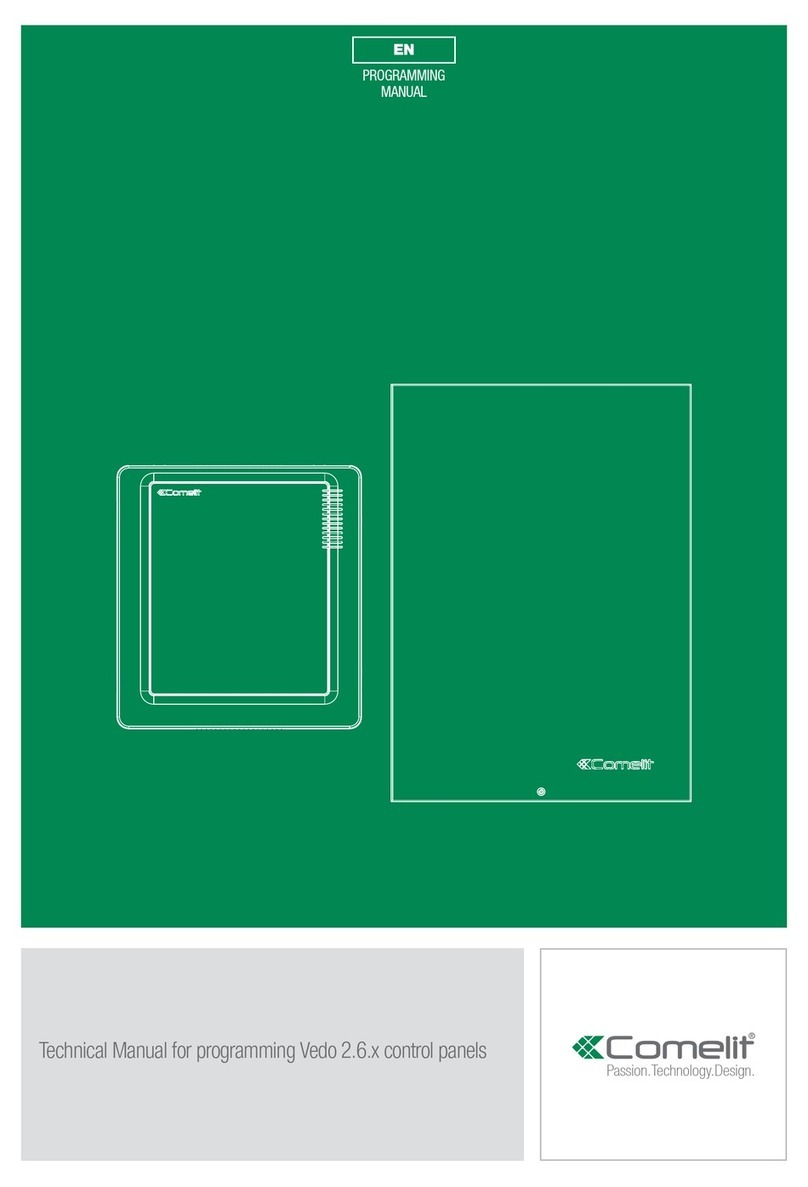
Comelit
Comelit VEDO 2.6 Series Programming manual
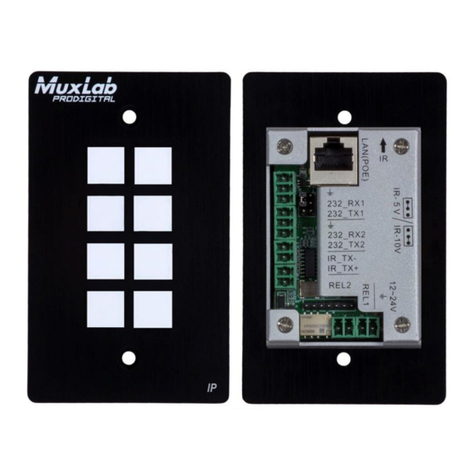
MuxLab
MuxLab 500816-IP-V2 Installation and operation manual
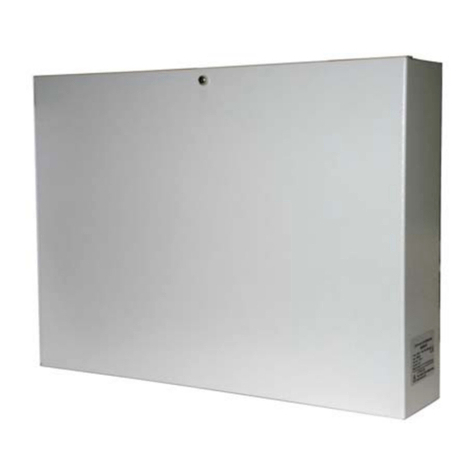
Elkron
Elkron MP500/16 User addendum
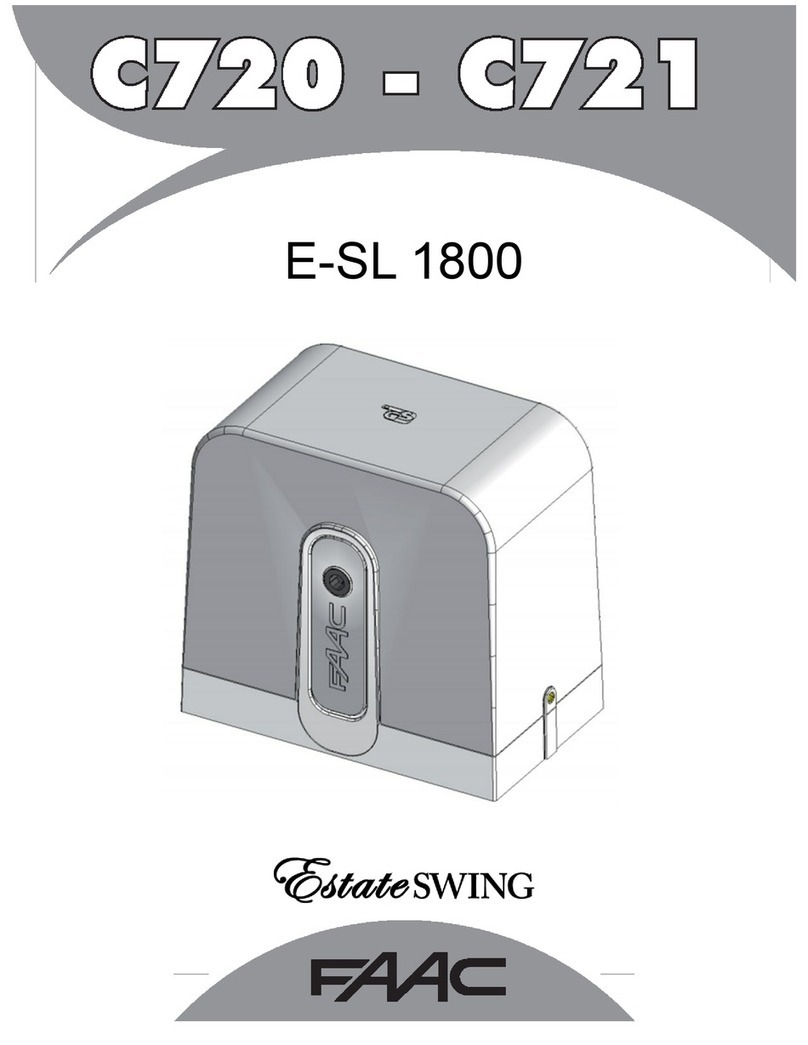
FAAC
FAAC Estate Swing E-SL 1800 installation manual

SJE Rhombus
SJE Rhombus 115 Installation Instructions and Operation

BLAUBERG Ventilatoren
BLAUBERG Ventilatoren S14 user manual
